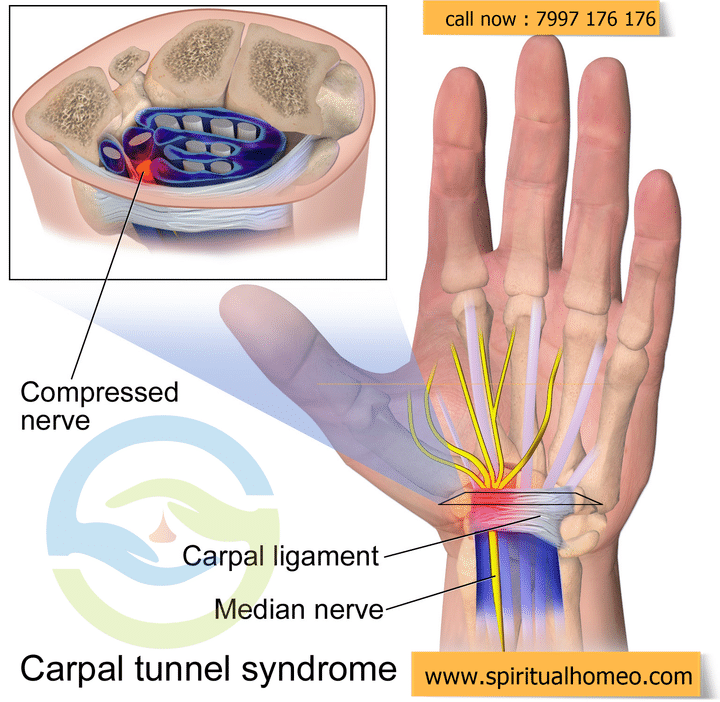What is Carpal tunnel syndrome?
What is Carpal tunnel syndrome ?
Carpal tunnel syndrome is a condition that causes numbness, tingling and other symptoms in the hand and arm. Carpal tunnel syndrome is caused by a compressed nerve in the carpal tunnel, a narrow passageway on the palm side of your wrist.The anatomy of your wrist, health problems and possibly repetitive hand motions can contribute to carpal tunnel syndrome.Proper treatment usually relieves the tingling and numbness and restores wrist and hand function.
What Are The Causes of Carpal Tunnel Syndrome?
The primary cause of carpal tunnel syndrome is the pressure on the median nerve. It is seen in certain health conditions like:
• Obesity
• Hypothyroidism
• Diabetes
• Fractures
What Are The Symptoms of Carpal Tunnel Syndrome?
Most common symptoms of carpal tunnel syndrome include an unpleasant tingling sensation, pain and numbness in the area through which the median nerve passes. This includes the thumb, index, middle finger and a part of the ring finger. These symptoms tend to worsen at night. During the day, the symptoms can cause clumsiness, often causing sufferers to drop things and have trouble picking things up. Here are some of the common symptoms:
• The tingling sensation or numbness in the fingers
• A sudden pain in the wrist that goes all the way to the hands
• A weakness of the hand and tendency to drop things
• A burning sensation that can even stay for a prolonged period
• Disturbance in the sleep due to pain at night
People with carpal tunnel say that a flick of the wrist helps in relieving symptoms.
Diagnosis :
History of symptoms. Your doctor will review the pattern of your symptoms. For example, because the median nerve doesn't provide sensation to your little finger, symptoms in that finger may indicate a problem other than carpal tunnel syndrome.
Carpal tunnel syndrome symptoms usually occur include while holding a phone or a newspaper, gripping a steering wheel, or waking up during the night.
Physical examination. Your doctor will conduct a physical examination. He or she will test the feeling in your fingers and the strength of the muscles in your hand.
Bending the wrist, tapping on the nerve or simply pressing on the nerve can trigger symptoms in many people.
X-ray. Some doctors recommend an X-ray of the affected wrist to exclude other causes of wrist pain, such as arthritis or a fracture.
Electromyogram. This test measures the tiny electrical discharges produced in muscles. During this test, your doctor inserts a thin-needle electrode into specific muscles to evaluate the electrical activity when muscles contract and rest. This test can identify muscle damage and also may rule out other conditions.
Nerve conduction study. In a variation of electromyography, two electrodes are taped to your skin. A small shock is passed through the median nerve to see if electrical impulses are slowed in the carpal tunnel. This test may be used to diagnose your condition and rule out other conditions.
How To Prevent Carpal Tunnel Syndrome?
As painful as the condition is, carpal tunnel syndrome is also easy to prevent.
Correct the posture: Posture: It is important to have a correct posture as it directly affects the wrists and the fingers.
Paying attention to the hand posture is important to make sure that the activity does not involve overextension of the wrists
Treat underlying conditions: Conditions like diabetes, arthritis and high blood pressure should not be neglected and treated properly because it can create tension in the median nerves as well.
Take a break: If your work involves the use of hands and fingers to a great extent, take breaks and gently stretch your hands and wrists.
Reduce the strain: Use a mouse that is comfortable and does not put a strain on your wrists.
Watch your form. Avoid bending your wrist all the way up or down. A relaxed middle position is best. Keep your keyboard at elbow height or slightly lower.



+1.svg)
